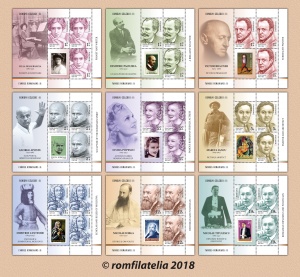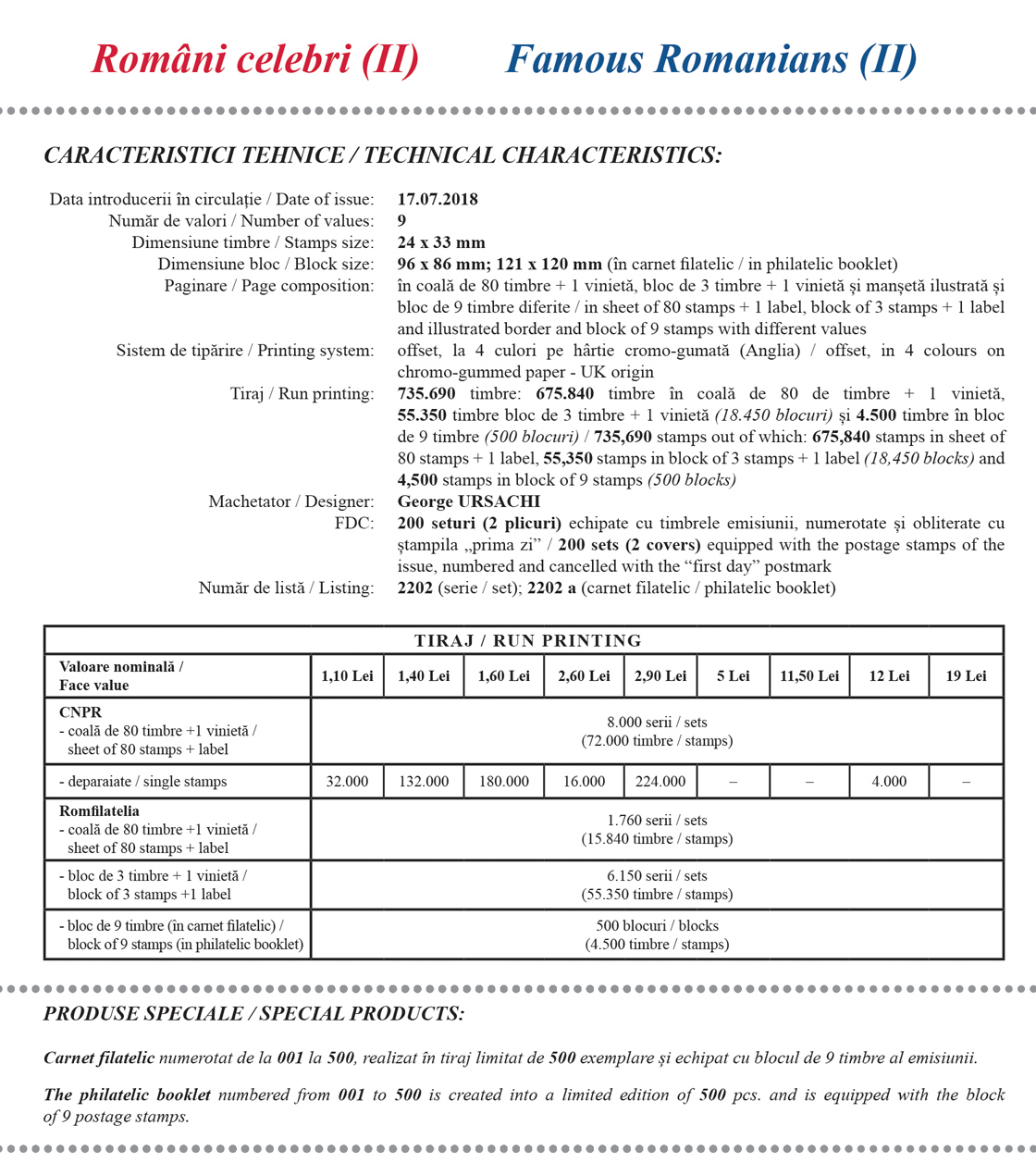 In the Centenary year of the 1918 Great Union, Romfilatelia introduces into circulation the postage stamp issue Famous Romanians, Part II, dedicated to several personalities that have honored Romania worldwide. The issue consists of nine stamps on which portraits of famous personalities are reproduced: Cella Delavrancea (Lei 1.10), Dimitrie Paciurea (Lei 1.40), Victor Brauner (Lei 1.60), George Apostu (Lei 2.60), Elvira Popesco (Lei 2.90), Marcel Iancu (Lei 5), Dimitrie Cantemir (Lei 11.50), Nicolae Iorga (Lei 12) and Nicolae Titulescu (Lei 19).
In the Centenary year of the 1918 Great Union, Romfilatelia introduces into circulation the postage stamp issue Famous Romanians, Part II, dedicated to several personalities that have honored Romania worldwide. The issue consists of nine stamps on which portraits of famous personalities are reproduced: Cella Delavrancea (Lei 1.10), Dimitrie Paciurea (Lei 1.40), Victor Brauner (Lei 1.60), George Apostu (Lei 2.60), Elvira Popesco (Lei 2.90), Marcel Iancu (Lei 5), Dimitrie Cantemir (Lei 11.50), Nicolae Iorga (Lei 12) and Nicolae Titulescu (Lei 19).
Cella Delavrancea (1887-1991) was a pianist, writer and publicist, a personality of Romanian culture in the 20th century. Daughter of the writer Barbu Stefanescu Delavrancea, according to her own testimonies, “grew up in a family where the conversations were mainly about literature, art and music”. Cella Delavrancea studied piano at the Conservatoire de Paris. After a performance in Vienna, Ion Luca Caragiale characterized her as “a wonder child, who tames a wild monster: the Art”. Cella Delavrancea has performed concerts throughout Europe, alongside great artists, often in duet with George Enescu. In 1950 she began teaching piano at the Music High School in Bucharest, and since 1954, she had been a professor at the Conservatoire. The artist launched several famous pianists such as Nicolae Licaret, Dan Grigore or Radu Lupu. Cella Delavrancea’s literary activity began in 1929, when she debuted in the Bilete de papagal magazine, edited by Tudor Arghezi. Later she will write for all the important cultural magazines of the time. In 1987, she was the first Romanian artist to attend the anniversary of her own Centenary, by a gala concert, at the Romanian Athenaeum.
Dimitrie Paciurea (1873-1932) was a landmark in monumental sculpture, an internationally appreciated artist for his innovative spirit. He began his studies at the School of Fine Arts in Bucharest, but the Parisian experience at the École des Beaux-Arts and the “Julian” Academy and the influence of A. Rodin was the one that helped him developed his own style. He exhibited in famous galleries in Munich, Brussels or Venice. The Romanian artist exceeded the rigors of the era, abandoning the rules of Academicism, in favor of a Surrealist approach of art. He is known, especially for the series of works with symbolic meanings for the Chimeras, by which he innovated and even pushed Expressionism towards a magical dimension. One of Paciurea’s Chimeras is exhibited in Leeds at the “Henry Moore” Institute. The work Gigantul (The Giant) can be admired by the audience in the Carol Park in Bucharest. Dimitrie Paciurea was a professor at the National School of Fine Arts in Bucharest, being a trailblazer for artists such as Ion Irimescu Oscar Han, or Ion Jalea.
Victor Brauner (1903-1966) was one of the important surrealist painters in the world, and his works are exposed in the great art galleries. He studied painting at the School of Fine Arts in Bucharest, but he did not adapt to the local artistic scenery due to his modernist vision. Brauner became known in Paris, where he met Brancusi and other modern artists of the time. In 1931 he painted the famous Self-portrait with his eye out, now in the collection of the Centre Georges Pompidou. The subject of blindness hunted the artist, and in an unfortunate incident, in 1936, he even lost his right eye. Victor Brauner found himself best in the ideas of French Surrealism, theorized by the writer André Breton. In his painting and graphics he presented a decadent world, a blurry and alienated society. His works often scandalized the audience, the artistic value being recognized only after his death. Brauner is the second, after Constantin Brancusi, in the classification of the best-rated Romanian graphic artists.
George Apostu (1934-1986) was one of the valuable Romanian sculptors of the last century. He graduated from the Institute of Fine Arts in Bucharest and in 1964 had his first personal exhibition, which impressed art critics. His works were presented in art galleries from France, Belgium, Italy, Spain, Brazil, India etc. Thanks to his talent, in 1983 he received an art workshop from the City Hall of Paris. George Apostu was inspired mainly by Romanian folk art, being compared to Brancusi. One of his most famous cycles is Tatal si Fiul (The Father and the Son), a sculptural processing of the “tree of life” old motif.
In other famous cycles, Laponele, respectively Fluturi (Butterflies), Apostu developed formal suggestions for peasant artifacts. The artist is also known for outdoor sculptures in Grenoble, France (1967), Magura, Buzau (1970 and 1975), Costinesti (1972), Voronet (1972) and Balta Alba – Bucharest (1972). He received awards from the Romanian Academy and the Union of Fine Artists in Romania.
Elvira Popesco (1894-1993) was a great French actress of Romanian origin. She was born in Bucharest and studied at the Conservatory for Dramatic Arts. After graduation, she was employed by the National Theater in Bucharest. She also starred at the “Excelsior” Theatre, and in 1922 she was among the founders of the “Mic” Theatre. In the following year she debuted on the Parisian stage at Théatre de la Michodičre, in a play especially written for her. Specialty critics were impressed by the performance of the actress, the chronicles of the time calling her Reine du Boulevard, Notre Dame du Théatre or Monstre Sacré. She led more successful troupes at the Théatre de Paris and Théatre Marigny. The fame on the great French scenes was confirmed by a special performance on the film sets. She starred in famous films, alongside great actors of the time: Claudia Cardinale, Vittorio de Sica, Jean Marais, Orson Welles, Alain Delon etc. Up to an advanced age, she continued to hold a salon in Paris, visited by artists or public figures such as Guy de Rotschild, Jacques Chirac, Pierre Cardin, or Valéry Giscard d’Estaing. In 1993 she was elected honorary member of the Romanian Academy.
Marcel Iancu (1895-1984) was a painter, designer and architect, one of the pioneers of worldwide avant-garde art. He had worked with Tristan Tzara since high school, a friendship that would continue in Zurich, a Swiss city where Iancu had moved in 1913 to study architecture at the Polytechnic Institute. They are among the founders of Dadaism. Marcel Iancu contributed to the birth of the avant-garde art by masks, posters and illustrations. His distinctive artistic style later emerged in Paris, between 1920-1922, where he participated in the ascension of modernist movement in art. After returning to Romania, Marcel Iancu came to a fore as an architect of urbanistic modernity. He designed over 40 buildings in Bucharest, influenced by cubism and constructivism. The villas built by Marcel Iancu have a functionalist architecture, giving up symmetry and ornaments. He introduced houses with a simple façade and roof-terrace, sloping roof and scuttle roof. In 1941, the artist moved to Palestine, and after the World War II he was stated as professor and cultural promoter in the new state of Israel.
Dimitrie Cantemir (1673-1723) was a humanist scholar and Ruler of Moldova (1693, 1710-1711), a remarkable personality who asserted himself as a writer, philosopher, historian, linguist and ethnologist. He began his studies at the Princely Academy in Iasi, and in 1688 he was sent to Istanbul, as a guarantee for his father’s loyalty to the Turks, that had become the Ruler of Moldova. He stayed in the capital of the Ottoman Empire for 22 years, where he trained from intellectual and political point of view. He had access to all the important writings of the time, being familiar with 12 foreign languages, including Greek, Latin, Slavic, Arabic, Turkish, Persian, Italian and French. In 1714 he became the first Romanian member of the Berlin Academy, at the proposal of the great philosopher Gottfried Wilhelm Leibniz.
The most important work of Catentimir is The history of the Ottoman Empire’s growth and decline and Descrierea Moldovei (Description of Moldova) written in Latin, through that the region between the Carpathians and the Dniester was presented to the Western world. In the pages of the three volumes of the writing we find information about Moldavian flora and fauna, administrative organization, language of Latin origin of Moldavians, ethnography and local folklore etc.
Nicolae Iorga (1871-1940) was a scholar and a politician, a remarkable personality of the Romanian cultural life. He studied Political Science and Philosophy in Paris, Berlin and Leipzig. After obtaining the PhD in Philosophy, in Leipzig (1893), Iorga returned to the country, working as a professor at the universities in Iasi and Bucharest. He was elected member of the Romanian Academy in 1910, and also in other academies and associations in the field from abroad (Paris, Rome, Oxford, Lisbon, Stockholm, Prague etc.). He founded the Institute for South East European Studies, the Institute of Byzantine Studies and the Institute of Universal History. His historic opera counts over 1,000 volumes and over 12,000 studies and articles. Iorga was among the great journalists of the time, and his articles were very influential in society. From a literary point of view, he was a theoretician of Samanatorism, a movement that promoted the traditional and folkloric national values and militated for the necessity of educating the peasantry. Nicolae Iorga was also involved in political life, and during 1931-1932 he was Prime-Minister.
Nicolae Titulescu (1882-1941) was the diplomat and politician of Romania. An excellent orator, he studied in Paris, where he obtained his PhD in Law (1905). He later returned to the country, working as a professor at the universities in Iasi and Bucharest. He was involved in political life in the Democrat-Conservative Party, being one of the politicians who fought for Romania’s entry into the World War II. During the Peace negotiations, he supported the cause of Romania, being a signatory, along with Dr. Ion Cantacuzino, of the Treaty of Trianon with Hungary. Starting with 1921, he was a permanent representative of Romania at the League of Nations. Between 1931 and 1932 he was president of this important international institution, being the sole Romanian who had such title, and also the only diplomat who had two mandates in the leadership of the League. Titulescu struggled at the international level to preserve the borders established by the Peace Treaty. Between 1928-1936 he was Foreign Minister during three terms of office, opposing to the rise of right-wing regimes in Europe. The Romanian Academy elected him as member in 1935 and his conferences were heard in the amphitheaters of large universities, such as Oxford or Cambridge.
Romfilatelia thanks the Romanian Academy Library, the National Archives of Romania, the National Museum of Romanian Literature and the University of Bucharest for their support granted in the achievement of this postage stamp issue.



